The Solidigm P41 Plus is a budget-friendly PCIe 4.0 SSD designed for a range of applications such as everyday productivity, content creation, and some gaming. It features 144-layer QLC NAND, comes in the M.2 2280 form factor, and is available in capacities ranging from 512GB to 2TB.
Solidigm was launched by SK hynix early this year to manage the company’s recently acquired Intel NAND and SSD technology. The P41 Plus is the result of this and is a direct successor to the Intel 670p, offering a better performance profile and handy new SSD management software.
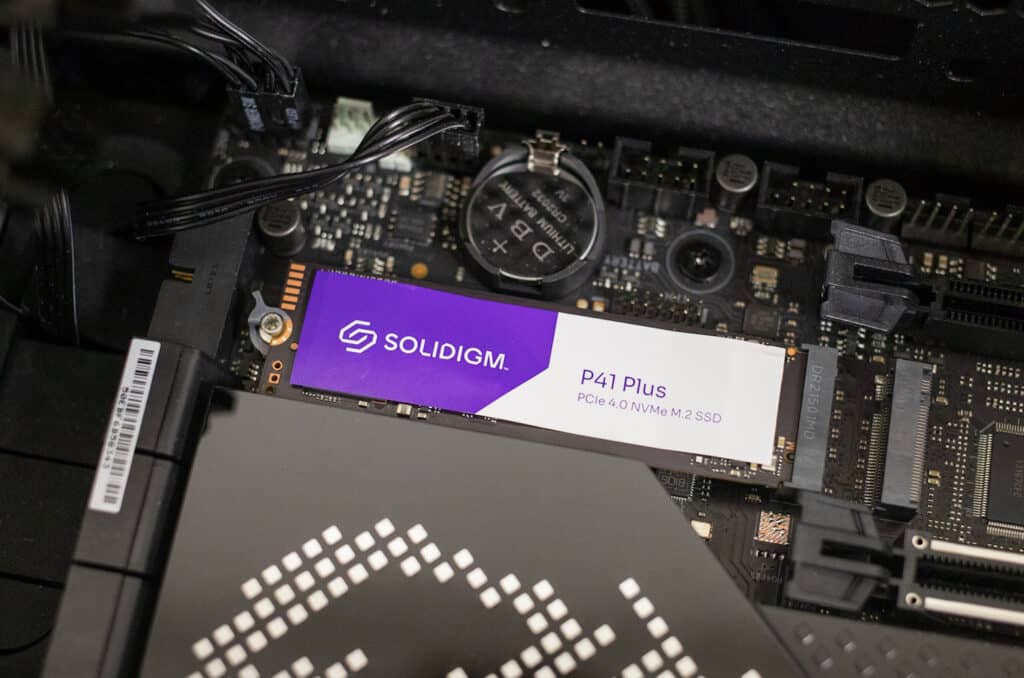
Solidigm P41 Plus Features
As far as performance goes, Solidigm quotes moderate transfer rates for the P41 Plus; though this is on par with what we’ve seen with other QLC-based drives. The drive is powered by a SiliconMotion SM2269XT family controller (SM2269XTF according to the board on our drive). There is no DRAM cache on this SSD.
For sequential read and write, the P41 is expected to reach up to 4,125MB/s (1TB and 2TB models) and 3,325MB/s (2TB model only), respectively. The 512GB model is quoted at 3,500MB/s read and 1,625MB/s write, which certainly puts this in the budget drive territory. It also features a 1.6 million hour Mean Time Between Failures (MTBF) rating, and while it does come with hardware encryption, it does have End-to-End Data Protection.

Solidigm Storage Tool and Synergy Storage Driver
The P41 Plus also comes bundled with Solidigm Synergy SSD management software, which is composed of two different components:
- The Synergy Storage Driver, which Solidigm claims can automatically boost performance by improving the connection between SSD and host system
- The Solidigm Synergy Storage Tool, which offers users a way to quickly view drive health, attain drive information reports, and execute functions like diagnostic scans and secure erase
Solidigm promises to keep its drives updated as frequently as possible to ensure optimal performance. In fact, they claim that the Synergy Storage Driver improved read and write speeds by (up to) 21% higher compared to the same systems running the default disk driver.
The Solidigm Storage Tool package is intuitive and features a simple easy-to-use interface. The Summary section displays at-a-glance information like the model and serial number, firmware version, protocol, manufacturer, controller, temperatures, remaining capacity, and the health status of the drive. All of this comes in handy if you need to service your drive.
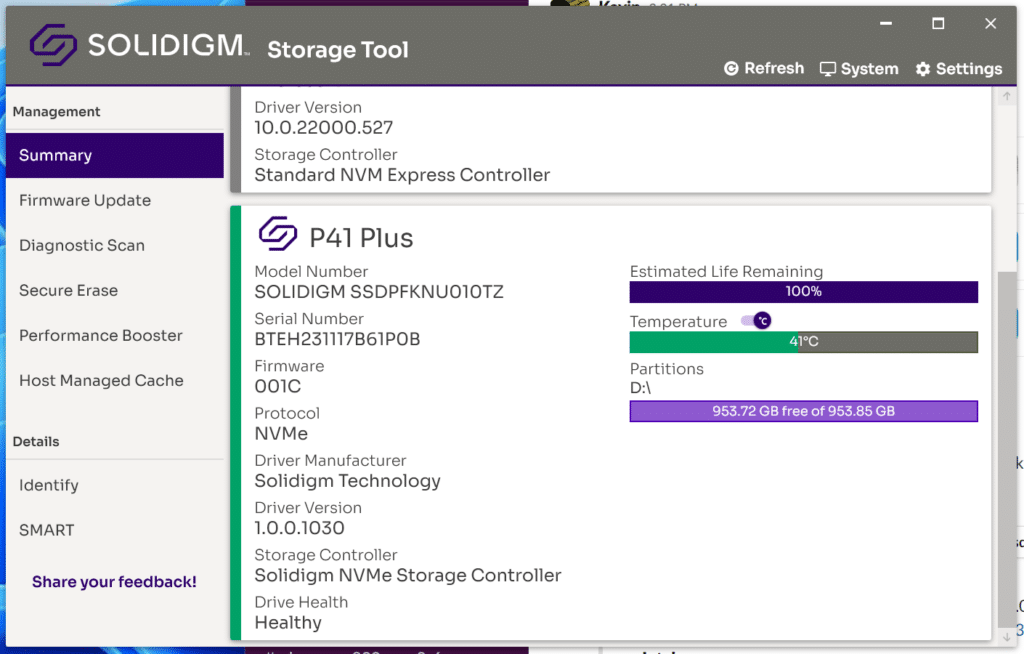
You can enable “host managed cache” here as well so it can automatically monitor usage patterns to identify high-priority data. This means it will keep the most important items in the cache, which translates to faster reads as you add more content to the P41 Plus drive.
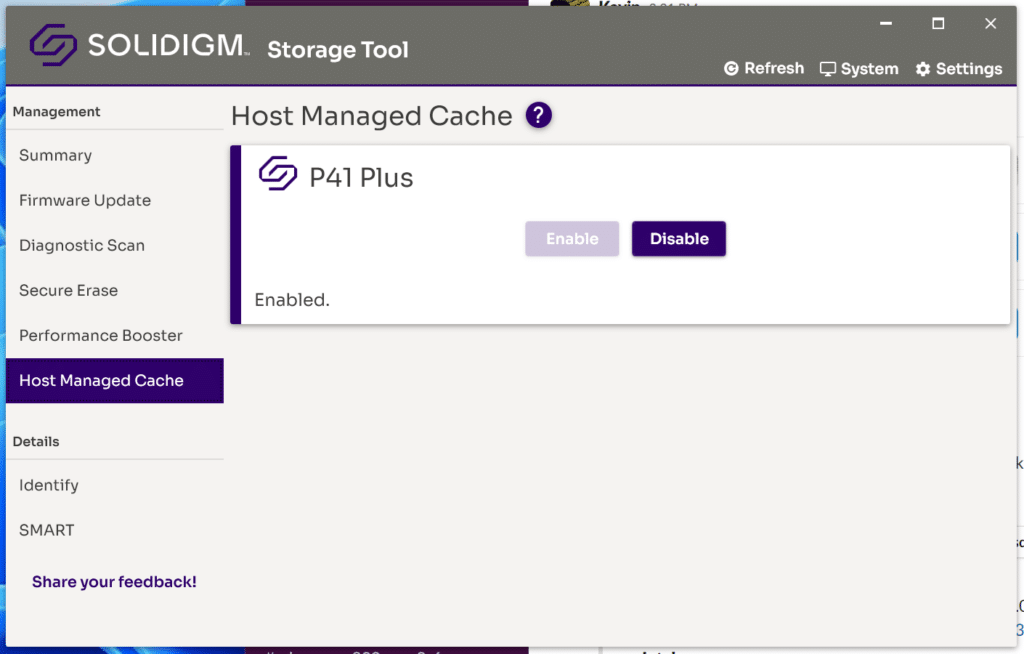
The Solidigm Storage Tool also allows you to update the firmware, try out a performance booster tool, securely erase the drive, and execute diagnostic and SMART scans. Overall, it’s a nice little piece of software to have and offers more than most other consumer drives.
Solidigm P41 Plus Pricing and Warranty
Backed by a 5-year warranty, the Solidigm P41 Plus goes for roughly $50 (512GB), $90 (1TB) and $170 (2TB). We will be looking at the 1TB model for this review.

Solidigm P41 Plus Specifications
| Capacity | 512GB | 1TB | 2TB |
| Performance Specifications | |||
| Sequential Bandwidth – 100% Read (up to) |
3,500MB/s |
4,125MB/s |
4,125MB/s |
| Sequential Bandwidth – 100% Write (up to) |
1,625MB/s |
2,950 MB/s |
3,325 MB/s |
| Power – Active | 80mW | ||
| Power – Idle | 25mW | ||
| Reliability | |||
| Vibration – Operating | 2.17 CRMS (5-700Hz) | ||
| Vibration – Non-Operating | 3.13 CRMS (5-700Hz) | ||
| Shock (Operating and Non-Operating) |
1,000 C (Max) at 0.5 msec 1,500 C (Max) at 0.5 msec |
||
| Operating Temperature Range | 0°C to 70°C | ||
|
Operating Temperature (Maximum) |
70 °C |
||
|
Operating Temperature (Minimum) |
0 °C |
||
|
Endurance Rating (Įifetime Writes) |
200 TBW |
400 TBW |
800 TBW |
|
Mean Time Between Failures (MTBF) |
1.6 million hours |
||
|
Uncorrectable Bit Error Rate (UBER) |
< 1 sector per 1015 bits read |
||
| Warranty Period | 5 years | ||
| Package Specifications | |||
| Ïorm Ïactors | M.2 22 x 80mm | ||
| Interface | PCIe 4.0 x4 | NVMe | ||
| Advanced Specifications | |||
| Hardware Encryption | No | ||
| End-to-End Data Protection | Yes | ||
| NSIT Secure Erase | No | ||
Testbed
As we migrate into testing newer NVMe Gen4 SSDs, it required a platform shift in our lab to support the newer interface. We’ve also been migrating newer NVMe Gen3 SSDs to the same platform for better apples-to-apples comparisons between drive generations. For these reviews, we leverage the Lenovo ThinkSystem SR635 server, equipped with an AMD 7742 CPU and 512GB of 3200Mhz DDR4 memory.
NVMe is tested natively through an M.2 to PCIe adapter card in the edge-card slot, while U.2 drives are loaded in the front. The methodology used better reflects end-user workflow with the consistency, scalability, and flexibility testing within virtualized server offers. A large focus is put on drive latency across the entire load range of the drive, not just at the smallest QD1 (Queue-Depth 1) levels. We do this because many of the common consumer benchmarks don’t adequately capture end-user workload profiles.
For our added BlackMagic Disk Speed Test performed in Windows, we use our self-built StorageReview desktop.
Solidigm P41 Plus Performance
We are reviewing the 1TB version of the Solidigm P41 Plus drive and will be comparing it to the following NVMe QLC SSDs:
SQL Server Performance
Each SQL Server VM is configured with two vDisks: 100GB volume for boot and a 500GB volume for the database and log files. From a system resource perspective, we configured each VM with 16 vCPUs, 64GB of DRAM and leveraged the LSI Logic SAS SCSI controller. While our Sysbench workloads tested previously saturated the platform in both storage I/O and capacity, the SQL test is looking for latency performance.
This test uses SQL Server 2014 running on Windows Server 2012 R2 guest VMs and is stressed by Quest’s Benchmark Factory for Databases. StorageReview’s Microsoft SQL Server OLTP testing protocol employs the current draft of the Transaction Processing Performance Council’s Benchmark C (TPC-C), an online transaction-processing benchmark that simulates the activities found in complex application environments.
The TPC-C benchmark comes closer than synthetic performance benchmarks to gauging the performance strengths and bottlenecks of storage infrastructure in database environments. Each instance of our SQL Server VM for this review uses a 333GB (1,500 scale) SQL Server database and measures the transactional performance and latency under a load of 15,000 virtual users.
SQL Server Testing Configuration (per VM)
- Windows Server 2012 R2
- Storage Footprint: 600GB allocated, 500GB used
- SQL Server 2014
- Database Size: 1,500 scale
-
- Virtual Client Load: 15,000
- RAM Buffer: 48GB
- Test Length: 3 hours
-
- 2.5 hours preconditioning
- 30 minutes sample period
Looking at SQL Server average latency, the Solidigm P41 Plus had an average latency of 187ms placing it way at the bottom of the leaderboard.
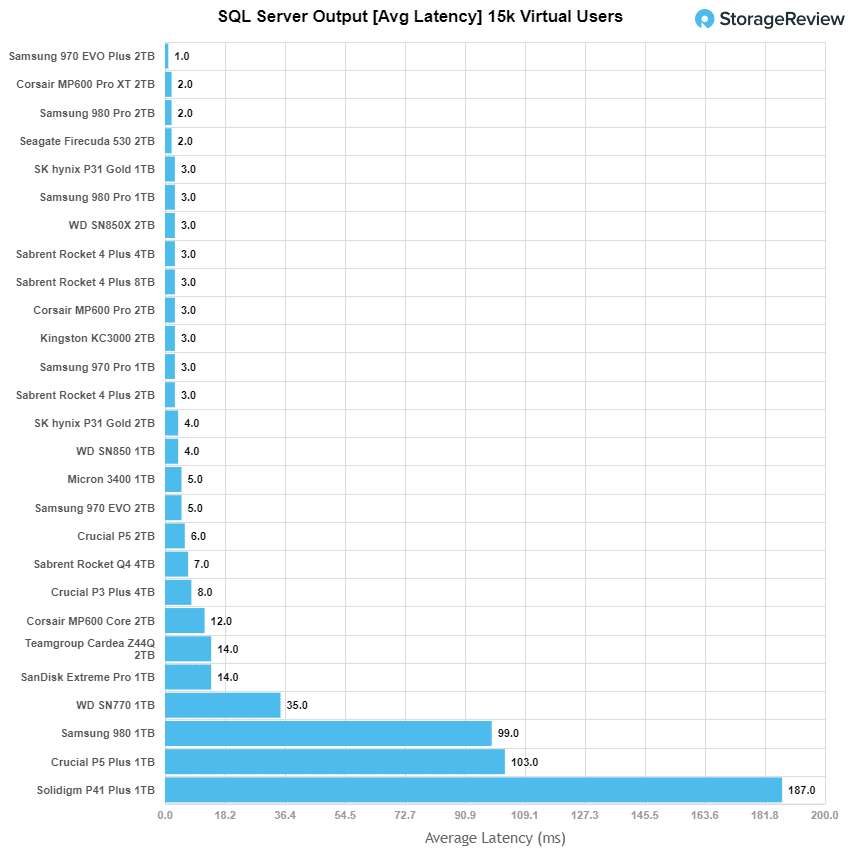
VDBench Workload Analysis
When it comes to benchmarking storage devices, application testing is best, and synthetic testing comes in second place. While not a perfect representation of actual workloads, synthetic tests do help to baseline storage devices with a repeatability factor that makes it easy to do an apples-to-apples comparison between competing solutions. These workloads offer a range of different testing profiles ranging from “four corners” tests, common database transfer size tests, to trace captures from different VDI environments.
All of these tests leverage the common vdBench workload generator, with a scripting engine to automate and capture results over a large compute testing cluster. This allows us to repeat the same workloads across a wide range of storage devices, including flash arrays and individual storage devices. Our testing process for these benchmarks fills the entire drive surface with data, then partitions a drive section equal to 1% of the drive capacity to simulate how the drive might respond to application workloads. This is different than full entropy tests which use 100% of the drive and take them into a steady state. As a result, these figures will reflect higher-sustained write speeds.
Profiles:
- 4K Random Read: 100% Read, 128 threads, 0-120% iorate
- 4K Random Write: 100% Write, 64 threads, 0-120% iorate
- 64K Sequential Read: 100% Read, 16 threads, 0-120% iorate
- 64K Sequential Write: 100% Write, 8 threads, 0-120% iorate
In 4K random read, the Solidigm P41 Plus showed a decent peak performance of 219k IOPS with a latency of 586.5ms before taking a slight spike at the very end.
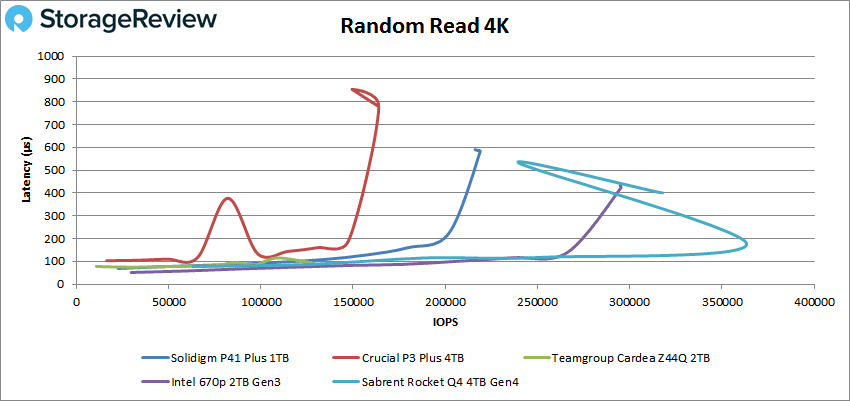
For 4K random write, P41 Plus took first place by a huge margin in throughput, peaking at an impressive 473,178 IOPS and 264.6ms. The next best drive was the Intel 670p 2TB (the model that the P41 is replacing), which hit just 287k IOPS with 414.8ms.
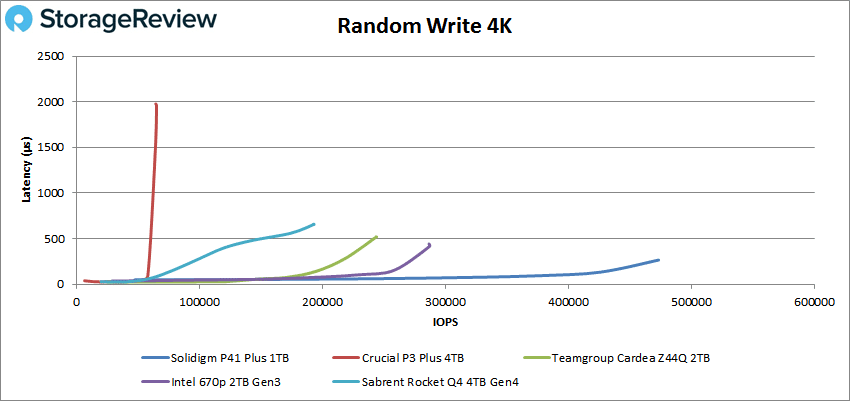
Switching to sequential workloads, where we look at our 64K tests, the P41 Plus continued its solid performance with a peak throughput of 49.6k IOPS (or 3.1GB/s) with a latency of 436µs. This was good enough to slightly trail the Teamgroup and Sabrent QLC drives.
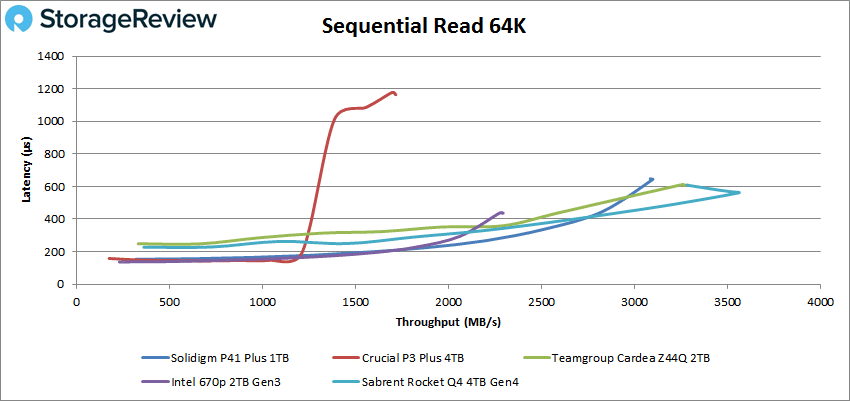
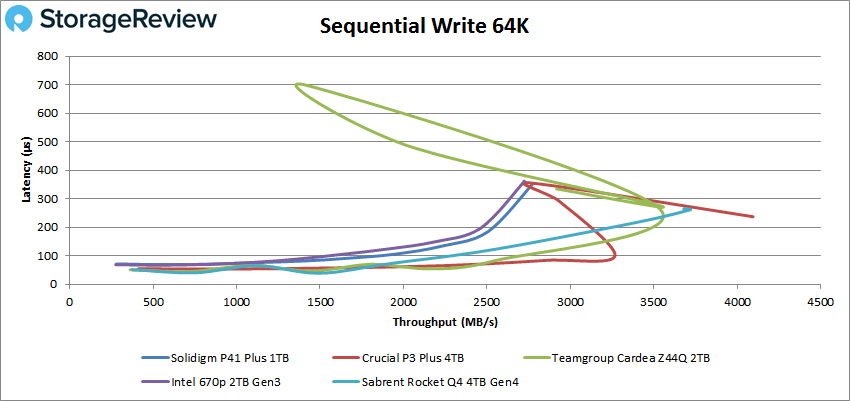
Next, we looked at our VDI benchmarks, which are designed to tax the drives even further. These tests include Boot, Initial Login, and Monday Login. Starting with Boot, the Solidigm P41 Plus had a peak of exactly 54k IOPS with a latency of 614.2µs, which was well back of the leaders but still much better than the Crucial P3 Plus.
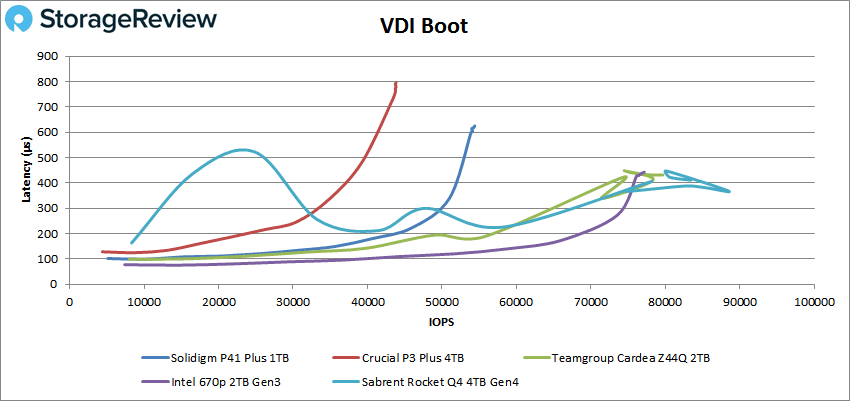
As evident below, our VDI Initial Login produced some messy results across the board in our charts. Nonetheless, the P41 Plus topped out at 39k IOPS (at 767.2ms) before it took then took a spike in performance at the end.
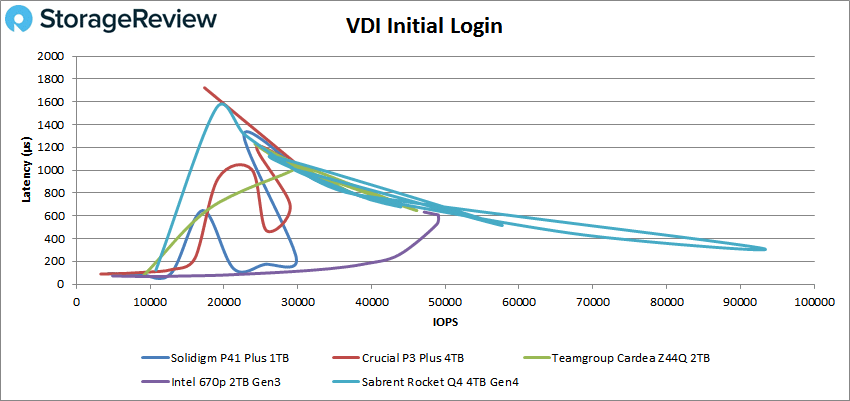
Finally, VDI Monday Login saw the P41 Plus peak at 28K IOPS (then spiking at the end) with a latency of 560µs before showing a slight dip at the very end.
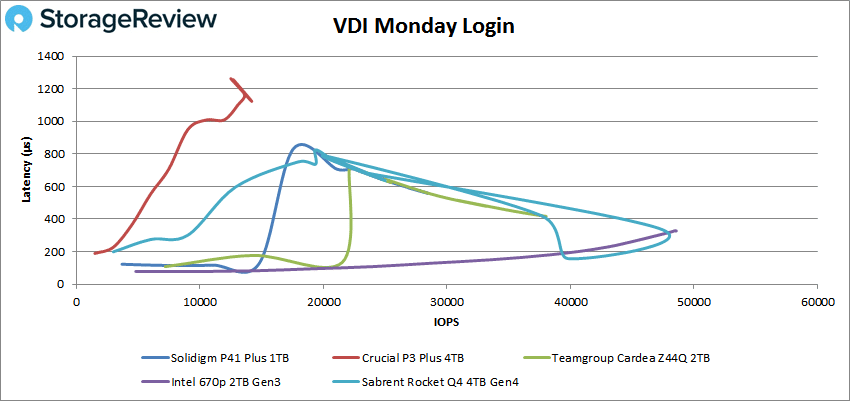
Solidigm P41 Plus Blackmagic Performance
Lastly is our Blackmagic transfer speed test, where we measure transfer speeds with the “host managed cache” option enabled and turned off.
When enabled, the Solidigm P41 Plus was able to reach 2,828.8MB/s read and 3,414.7MB/s write.
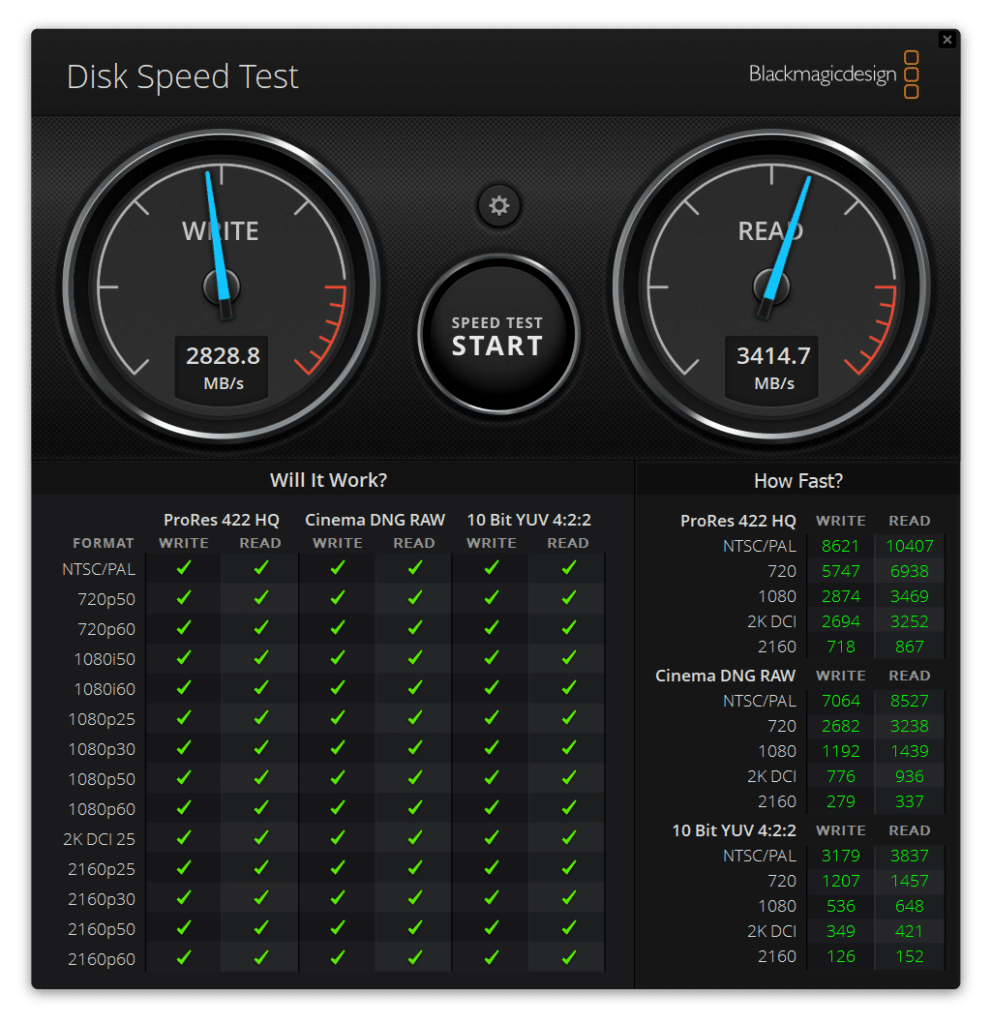
When disabled, it posted noticeably slower read performance at 2,582.9MB/s read while writes remained (as expected) relatively the same at 3,410.1MB/s write.
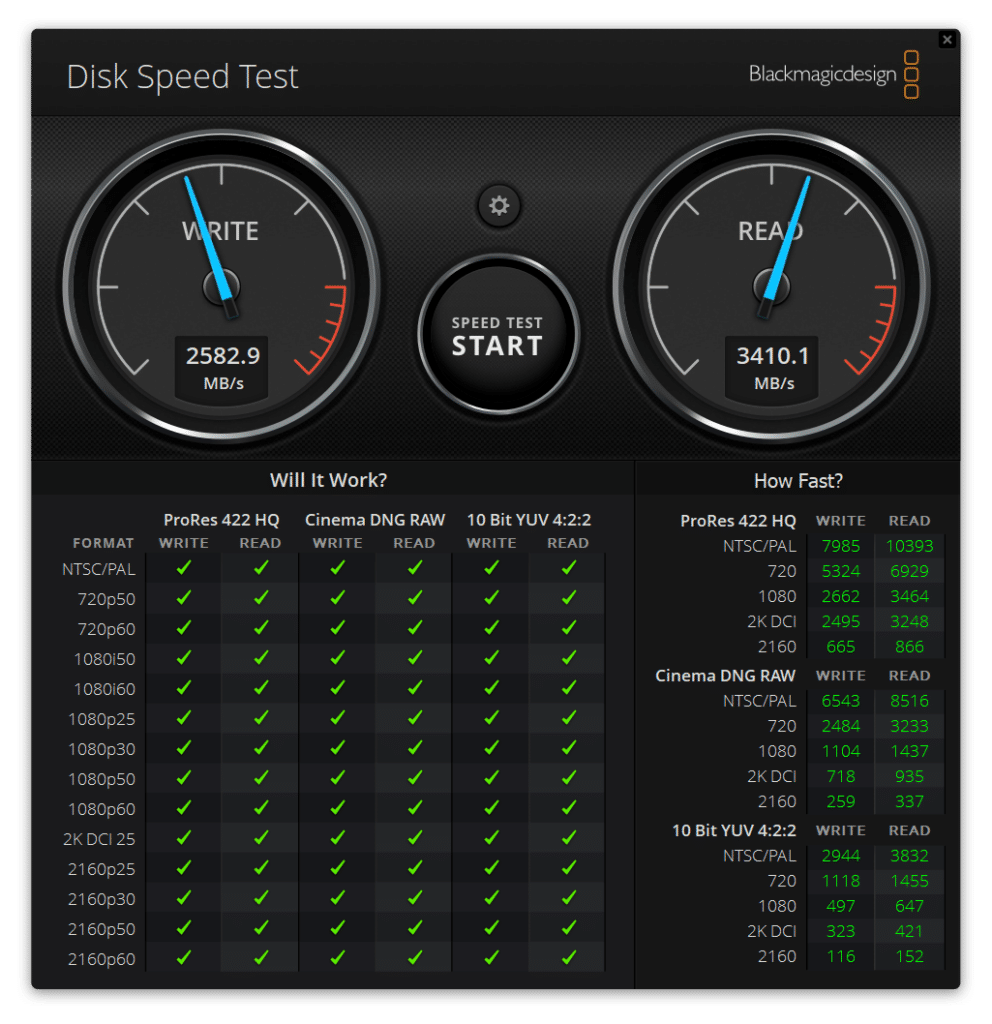
Conclusion
The Solidigm P41 Plus is a solid budget consumer Gen4 SSD for everyday productivity and light content creation/gaming use cases. Like its predecessor, the Intel 670p, it features 144-layer QLC NAND in the M.2 2280 form factor. It also comes with handy drive and SSD management software, Solidigm Storage Tool and Synergy Storage Driver, respectively, and is available in capacities of 512GB, 1TB, and 2TB.

As far as its performance goes, the P41 Plus showed some great results for a QLC-based SSD. Specifics include 219k IOPS in 4K random reads, an impressive 473,178 IOPS in 4K random writes (greatly improving on its predecessor), 49.3k IOPS (or 3.1GB/s) in sequential reads and 44k IOPS (or 2.77GB/s) in sequential writes.
The P41 Plus showed mid-range results during our VDI benchmarks, tests of which tax the drives even further. With our Boot profile, the Solidigm P41 Plus had a peak of exactly 54k IOPS, while initial and Monday login tests topped out at 39k IOPS and 28k IOPS, respectively. That said, it fared very poorly in SQL server performance (though this drive certainly isn’t meant for intensive workloads, it is interesting data).
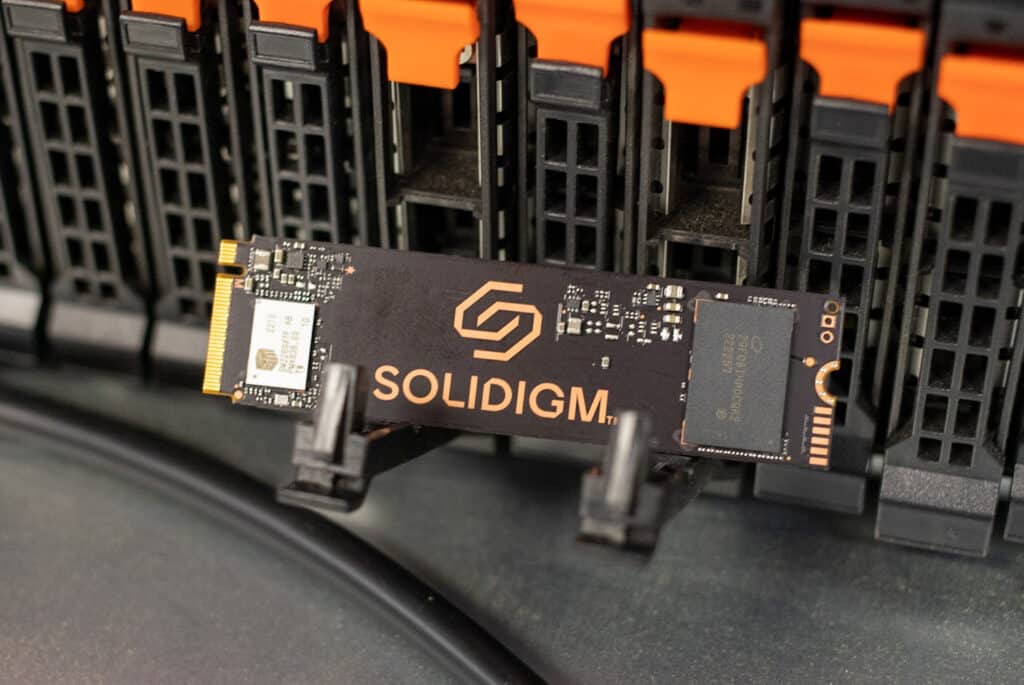
We also put it through our usual Blackmagic transfer speed test, where we measured performance with both the “host managed cache” option enabled and disabled. For the former, the Solidigm P41 Plus was able to reach 2,828.8MB/s read and 3,414.7MB/s write while posting noticeably slower read performance at 2,582.9MB/s read (writes remained relatively the same at 3,410.1MB/s write) with cache disabled. For systems that support this option, the exercise might be worth the effort.
Though it doesn’t stand out too much among the other PCIe Gen4 QLC drives out there, the P41 Plus offers a noticeable uptick in performance compared to the Intel 670p. At just $50 for the 512GB model and $90 for the 1TB model, the P41 Plus is a solid overall release by Solidigm, making it a great choice for general consumers looking to add an affordable, everyday-use drive to their rig.




 Amazon
Amazon